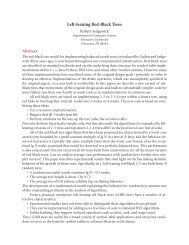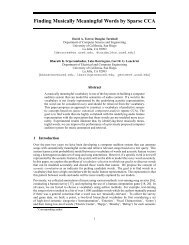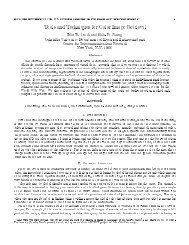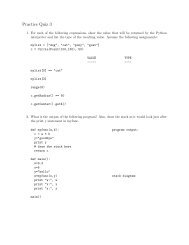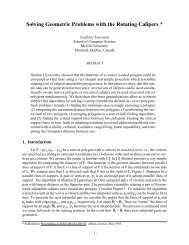Derivation of Backpropagation
Derivation of Backpropagation
Derivation of Backpropagation
You also want an ePaper? Increase the reach of your titles
YUMPU automatically turns print PDFs into web optimized ePapers that Google loves.
<strong>Derivation</strong> <strong>of</strong> <strong>Backpropagation</strong><br />
1 Introduction<br />
Figure 1: Neural network processing<br />
Conceptually, a network forward propagates activation to produce an output and it backward<br />
propagates error to determine weight changes (as shown in Figure 1). The weights on the connections<br />
between neurons mediate the passed values in both directions.<br />
The <strong>Backpropagation</strong> algorithm is used to learn the weights <strong>of</strong> a multilayer neural network with<br />
a fixed architecture. It performs gradient descent to try to minimize the sum squared error between<br />
the network’s output values and the given target values.<br />
Figure 2 depicts the network components which affect a particular weight change. Notice that<br />
all the necessary components are locally related to the weight being updated. This is one feature<br />
<strong>of</strong> backpropagation that seems biologically plausible. However, brain connections appear to be<br />
unidirectional and not bidirectional as would be required to implement backpropagation.<br />
2 Notation<br />
For the purpose <strong>of</strong> this derivation, we will use the following notation:<br />
• The subscript k denotes the output layer.<br />
• The subscript j denotes the hidden layer.<br />
• The subscript i denotes the input layer.<br />
1
Figure 2: The change to a hidden to output weight depends on error (depicted as a lined pattern)<br />
at the output node and activation (depicted as a solid pattern) at the hidden node. While the<br />
change to a input to hidden weight depends on error at the hidden node (which in turn depends<br />
on error at all the output nodes) and activation at the input node.<br />
• w kj denotes a weight from the hidden to the output layer.<br />
• w ji denotes a weight from the input to the hidden layer.<br />
• a denotes an activation value.<br />
• t denotes a target value.<br />
• net denotes the net input.<br />
3 Review <strong>of</strong> Calculus Rules<br />
d(e u )<br />
dx = eudu dx<br />
d(g + h)<br />
dx<br />
= dg<br />
dx + dh<br />
dx<br />
d(g n )<br />
dx<br />
dg<br />
= ngn−1<br />
dx<br />
4 Gradient Descent on Error<br />
We can motivate the backpropagation learning algorithm as gradient descent on sum-squared error<br />
(we square the error because we are interested in its magnitude, not its sign). The total error in a<br />
network is given by the following equation (the 1 2<br />
will simplify things later).<br />
E = 1 ∑<br />
(t k − a k ) 2<br />
2<br />
k<br />
We want to adjust the network’s weights to reduce this overall error.<br />
∆W ∝ − ∂E<br />
∂W<br />
We will begin at the output layer with a particular weight.<br />
2
∆w kj ∝ − ∂E<br />
∂w kj<br />
However error is not directly a function <strong>of</strong> a weight. We expand this as follows.<br />
∆w kj = −ε ∂E ∂a k ∂net k<br />
∂a k ∂net k ∂w kj<br />
Let’s consider each <strong>of</strong> these partial derivatives in turn. Note that only one term <strong>of</strong> the E summation<br />
will have a non-zero derivative: the one associated with the particular weight we are considering.<br />
4.1 Derivative <strong>of</strong> the error with respect to the activation<br />
Now we see why the 1 2<br />
∂E<br />
= ∂(1 2 (t k − a k ) 2 )<br />
= −(t k − a k )<br />
∂a k ∂a k<br />
in the E term was useful.<br />
4.2 Derivative <strong>of</strong> the activation with respect to the net input<br />
∂a k<br />
= ∂(1 + e−net k) −1<br />
=<br />
∂net k ∂net k<br />
e −net k<br />
(1 + e −net k ) 2<br />
We’d like to be able to rewrite this result in terms <strong>of</strong> the activation function. Notice that:<br />
1<br />
1 −<br />
1 + e −net = e−net k<br />
k 1 + e −net k<br />
Using this fact, we can rewrite the result <strong>of</strong> the partial derivative as:<br />
a k (1 − a k )<br />
4.3 Derivative <strong>of</strong> the net input with respect to a weight<br />
Note that only one term <strong>of</strong> the net summation will have a non-zero derivative: again the one<br />
associated with the particular weight we are considering.<br />
∂net k<br />
= ∂(w kja j )<br />
= a j<br />
∂w kj ∂w kj<br />
4.4 Weight change rule for a hidden to output weight<br />
Now substituting these results back into our original equation we have:<br />
δ k<br />
{ }} {<br />
∆w kj = ε(t k − a k )a k (1 − a k ) a j<br />
Notice that this looks very similar to the Perceptron Training Rule. The only difference is the<br />
inclusion <strong>of</strong> the derivative <strong>of</strong> the activation function. This equation is typically simplified as shown<br />
below where the δ term repesents the product <strong>of</strong> the error with the derivative <strong>of</strong> the activation<br />
function.<br />
∆w kj = εδ k a j<br />
3
4.5 Weight change rule for an input to hidden weight<br />
Now we have to determine the appropriate weight change for an input to hidden weight. This is<br />
more complicated because it depends on the error at all <strong>of</strong> the nodes this weighted connection can<br />
lead to.<br />
∆w ji ∝ −[ ∑ ∂E ∂a k ∂net k ∂a j ∂net j<br />
]<br />
∂a<br />
k k ∂net k ∂a j ∂net j ∂w ji<br />
= ε[ ∑ k<br />
δ k<br />
{ }} {<br />
(t k − a k )a k (1 − a k )w kj ]a j (1 − a j )a i<br />
δ j<br />
{ }} {<br />
= ε[ ∑ δ k w kj ]a j (1 − a j ) a i<br />
k<br />
∆w ji = εδ j a i<br />
4



